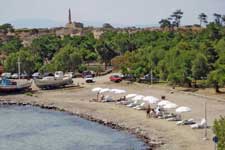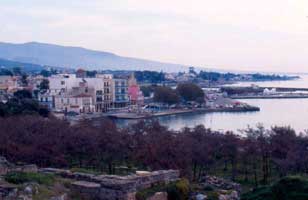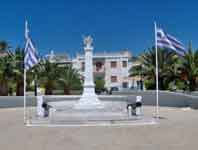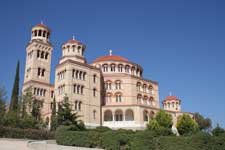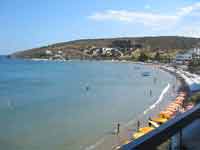.


Administrative Region : Attica
Regional unit : Islands



Aegina, Photo / Source: Ricardo André Frantz, See also Aegina Harbour
Aegina ( /ɨˈdʒaɪnə/; Greek: Αίγινα - Aígina [ˈeʝina]) is one of the Saronic Islands of Greece in the Saronic Gulf, 17 miles (27 km) from Athens. Tradition derives the name from Aegina, the mother of Aeacus, who was born in and ruled the island. During ancient times, Aegina was a rival to Athens, the great sea power of the era.© OpenStreetMap contributors,
Municipality
The municipality Aegina consists of the island Aegina and a few offshore islets. It is part of the Islands peripheral unit, Attica Periphery. The municipality is subdivided into the following five communities (population in 2001 in brackets):[1]
Aegina (7783)
Kypseli (1949)
Mesagros (1603)
Perdika (743)
Vathy (1474)
The capital is the town of Aegina, situated at the northwestern end of the island. Due to its proximity to Athens, it is a popular quick getaway during the summer months, with quite a few Athenians owning second houses on the island.
Geography
Aegina is roughly triangular in shape, approximately 15 km (9.3 mi) from east to west and 10 km (6.2 mi) from north to south, with an area of about 87 km2 (34 sq mi).
An extinct volcano constitutes two thirds of Aegina. The northern and western side consist of stony but fertile plains, which are well cultivated and produce luxuriant crops of grain, with some cotton, vines, almonds, olives and figs, but the most characteristic crop of Aegina today (2000s) is pistachio. Economically, the sponge fisheries are of notable importance. The southern volcanic part of the island is rugged and mountainous, and largely barren. Its highest rise is the conical Mount Oros (531 m) in the south, and the Panhellenian ridge stretches northward with narrow fertile valleys on either side.
The beaches are also a popular tourist attraction. Hydrofoil ferries from Piraeus take only forty minutes to reach Aegina; the regular ferry takes about an hour, with ticket prices for adults within the 4-15 euro range. There are regular bus services from Aegina town to destinations throughout the island such as Agia Marina. Portes is a fishing village on the east coast.
History
Prehistory
Prehistoric archaeological findings of settlements with obsidian tools points to an early habitation of the island.[CN]
Earliest history (20th–7th centuries BC)
Aegina, according to Herodotus,[2] was a colony of Epidaurus, to which state it was originally subject. Its placement between Attica and the Peloponnesus made it a center of trade even earlier, and its earliest inhabitant came from Asia Minor.[3] Minoan ceramics have been found in contexts of ca. 2000 BC. The discovery in the island of a number of gold ornaments belonging to the latest period of Mycenaean art suggests the inference that the Mycenaean culture held its own in Aegina for some generations after the Dorian conquest of Argos and Lacedaemon.[4] It is probable that the island was not doricized before the 9th century BC.
One of the earliest historical facts is its membership in the League of Calauria (Calaurian Amphictyony, ca. 8th century BC), which included, besides Aegina, Athens, the Minyan (Boeotian) Orchomenus, Troezen, Hermione, Nauplia and Prasiae, and was probably an organization of city-states that were still Mycenaean, for the purpose of suppressing piracy in the Aegean that arose as a result of the decay of the naval supremacy of the Mycenaean princes.
Aegina appears to have belonged to the Eretrian league during the Lelantine War; hence, perhaps, we may explain the war with Samos, a leading member of the rival Chalcidian league in the reign of King Amphicrates (Herod. iii. 59), i.e. not later than the earlier half of the 7th century BC.
Rise as a sea power (6th–5th centuries BC)
Greek drachma of Aegina. Obverse: Land tortoise. / Reverse: ΑΙΓ(INA) and dolphin
It follows, therefore, that the maritime importance of the island dates back to pre-Dorian times. It is usually stated on the authority of Ephorus, that Pheidon of Argos established a mint in Aegina. For example, Kydonia on Crete began minting coins by over-striking Aeginetan specimens. Thus it was the Aeginetans who, within 30 or 40 years of the invention of coinage in Asia Minor by the Ionian Greeks or the Lydians (c. 630 BC), introduced coinage to the Western world. The fact that the Aeginetan standard of weights and measures (developed in the mid-7th century) was one of the two standards in general use in the Greek world (the other being the Euboic-Attic) is sufficient evidence of the early commercial importance of the island.
During the naval expansion of Aegina during the Archaic Period, Kydonia was an ideal maritime stop for Aegina's fleet on its way to other Mediterranean ports controlled by the emerging sea-power Aegina.[5] During the next century Aegina is one of the three principal states trading at the emporium of Naucratis, and it is the only state of European Greece that has a share in this factory.[6] At the beginning of the 5th century it seems to have been an entrepôt of the Pontic grain trade, at a later date an Athenian monopoly.[7]
Unlike the other commercial states of the 7th and 6th centuries BC, such as Corinth, Chalcis, Eretria and Miletus, Aegina founded no colonies. The settlements to which Strabo refers (viii. 376) cannot be regarded as any real exceptions to this statement.
Rivalry with Athens (5th century BC)
The history of Aegina, as it has come down to us, is almost exclusively a history of its relations with the neighbouring state of Athens, which began to compete with the thalassocracy of Aegina at the beginning of the sixth century. Solon passed laws limiting Aeginetan commerce in Attica. The legendary history of these relations, as recorded by Herodotus (v. 79-89; vi. 49-51, 73, 85-94), involves critical problems of some difficulty and interest. He traces back the hostility of the two states to a dispute about the images of the goddesses Damia and Auxesia, which the Aeginetes had carried off from Epidauros, their parent state.
The Epidaurians had been accustomed to make annual offerings to the Athenian deities Athena and Erechtheus in payment for the Athenian olive-wood of which the statues were made. Upon the refusal of the Aeginetes to continue these offerings, the Athenians endeavoured to carry away the images. Their design was miraculously frustrated – according to the Aeginetan version, the statues fell upon their knees – and only a single survivor returned to Athens, there to fall a victim to the fury of his comrades' widows, who pierced him with their brooch-pins. No date is assigned by Herodotus for this old feud; recent writers, e.g. J. B. Bury and R. W. Macan, suggest the period between Solon and Peisistratus, circa 570 BC. It may be questioned, however, whether the whole episode is not mythical. A critical analysis of the narrative seems to reveal little else than a series of aetiological traditions (explanatory of cults and customs, e.g. of the kneeling posture of the images of Damia and Auxesia, of the use of native ware instead of Athenian in their worship, and of the change in women's dress at Athens from the Dorian to the Ionian style.
The Temple of Aphaea.
The account which Herodotus gives of the hostilities between the two states in the early years of the 5th century BC is to the following effect. Thebes, after the defeat by Athens about 507 BC, appealed to Aegina for assistance. The Aeginetans at first contented themselves with sending the images of the Aeacidae, the tutelary heroes of their island. Subsequently, however, they entered into an alliance, and ravaged the seaboard of Attica. The Athenians were preparing to make reprisals, in spite of the advice of the Delphic oracle that they should desist from attacking Aegina for thirty years, and content themselves meanwhile with dedicating a precinct to Aeacus, when their projects were interrupted by the Spartan intrigues for the restoration of Hippias.
In 491 BC Aegina was one of the states which gave the symbols of submission (earth and water) to Achaemenid Persia. Athens at once appealed to Sparta to punish this act of medism, and Cleomenes I, one of the Spartan kings, crossed over to the island, to arrest those who were responsible for it. His attempt was at first unsuccessful; but, after the deposition of Demaratus, he visited the island a second time, accompanied by his new colleague Leotychides, seized ten of the leading citizens and deposited them at Athens as hostages.
After the death of Cleomenes and the refusal of the Athenians to restore the hostages to Leotychides, the Aeginetans retaliated by seizing a number of Athenians at a festival at Sunium. Thereupon the Athenians concerted a plot with Nicodromus, the leader of the democratic party in the island, for the betrayal of Aegina. He was to seize the old city, and they were to come to his aid on the same day with seventy vessels. The plot failed owing to the late arrival of the Athenian force, when Nicodromus had already fled the island. An engagement followed in which the Aeginetans were defeated. Subsequently, however, they succeeded in winning a victory over the Athenian fleet.
All the incidents subsequent to the appeal of Athens to Sparta are expressly referred by Herodotus to the interval between the sending of the heralds in 491 BC and the invasion of Datis and Artaphernes in 490 BC (cf. Herod. vi. 49 with 94).
There are difficulties in this story, of which the following are the principal elements: –
(i.) Herodotus nowhere states or implies that peace was concluded between the two states before 481 BC, nor does he distinguish between different wars during this period. Hence it would follow that the war lasted from shortly after 507 BC down to the congress at the Isthmus of Corinth in 481 BC
(ii.) It is only for two years (490 and 491) out of the twenty-five that any details are given. It is the more remarkable that no incidents are recorded in the period between Marathon and Salamis, since at the time of the Isthmian Congress the war is described as the most important one then being waged in Greece (Herod. vii. 145).
(iii.) It is improbable that Athens would have sent twenty vessels to the aid of the Ionians in 499 BC if at the time she was at war with Aegina. (iv.) There is an incidental indication of time, which points to the period after Marathon as the true date for the events which are referred by Herodotus to the year before Marathon, viz. the thirty years that were to elapse between the dedication of the precinct to Aeacus and the final victory of Athens (Herod. v. 89).
The ruins of the Temple of Apollo.
As the final victory of Athens over Aegina was in 458 B.C., the thirty years of the oracle would carry us back to the year 488 BC as the date of the dedication of the precinct and the outbreak of hostilities. This inference is supported by the date of the building of the 200 triremes for the war against Aegina on the advice of Themistocles, which is given in the Constitution of Athens as 483-482 BC (Herod. vii. 144; Ath. Pol. r2. 7). It is probable, therefore, that Herodotus is in error both in tracing back the beginning of hostilities to an alliance between Thebes and Aegina (c. 507 BC) and in putting the episode of Nicodromus before Marathon.
Overtures were unquestionably made by Thebes for an alliance with Aegina c. 507 BC, but they came to nothing. The refusal of Aegina was veiled under the diplomatic form of sending the Aeacidae. The real occasion of the outbreak of the war was the refusal of Athens to restore the hostages some twenty years later. There was but one war, and it lasted from 488 to 481. That Athens had the worst of it in this war is certain.
Herodotus had no Athenian victories to record after the initial success, and the fact that Themistocles was able to carry his proposal to devote the surplus funds of the state to the building of so large a fleet seems to imply that the Athenians were themselves convinced that a supreme effort was necessary.
It may be noted, in confirmation of this view, that the naval supremacy of Aegina is assigned by the ancient writers on chronology to precisely this period, i.e. the years 490-480 (Eusebius, Chron. Can. p. 337).




Aegina, Aegina, Aegina , Aegina
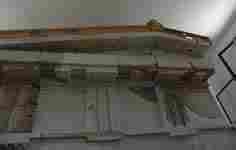

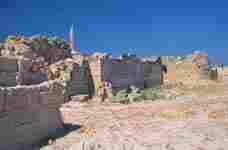
Decline
In the repulse of Xerxes I it is possible that the Aeginetans played a larger part than is conceded to them by Herodotus. The Athenian tradition, which he follows in the main, would naturally seek to obscure their services. It was to Aegina rather than Athens that the prize of valour at Salamis was awarded, and the destruction of the Persian fleet appears to have been as much the work of the Aeginetan contingent as of the Athenian (Herod. viii. 91). There are other indications, too, of the importance of the Aeginetan fleet in the Greek scheme of defence. In view of these considerations it becomes difficult to credit the number of the vessels that is assigned to them by Herodotus (30 as against 180 Athenian vessels, cf. Greek History, sect. Authorities). During the next twenty years the Philo-Laconian policy of Cimon secured Aegina, as a member of the Spartan league, from attack. The change in Athenian foreign policy, which was consequent upon the ostracism of Cimon in 461, led to what is sometimes called the First Peloponnesian War, in which the brunt of the fighting fell upon Corinth and Aegina. The latter state was forced to surrender to Athens after a siege, and to accept the position of a subject-ally (c. 456 BC). The tribute was fixed at 30 talents.
By the terms of the Thirty Years' Peace (445 BC) Athens covenanted to restore to Aegina her autonomy, but the clause remained a dead letter. In the first winter of the Peloponnesian War (431 BC) Athens expelled the Aeginetans and established a cleruchy in their island. The exiles were settled by Sparta in Thyreatis, on the frontiers of Laconia and Argolis. Even in their new home they were not safe from Athenian rancour. A force landed under Nicias in 424, and put most of them to the sword. At the end of the Peloponnesian War Lysander restored the scattered remnants of the old inhabitants to the island, which was used by the Spartans as a base for operations against Athens in the Corinthian War. Its greatness, however, was at an end. The part which it plays henceforward is insignificant.

It would be a mistake to attribute the fall of Aegina solely to the development of the Athenian navy. It is probable that the power of Aegina had steadily declined during the twenty years after Salamis, and that it had declined absolutely, as well as relatively, to that of Athens. Commerce was the source of Aegina's greatness, and her trade, which appears to have been principally with the Levant, must have suffered seriously from the war with Persia. Her medism in 491 is to be explained by her commercial relations with the Persian Empire. She was forced into patriotism in spite of herself, and the glory won by Salamis was paid for by the loss of her trade and the decay of her marine. The completeness of the ruin of so powerful a state finds an explanation in the economic conditions of the island, the prosperity of which rested upon a basis of slave-labour. It is impossible, indeed, to accept Aristotle's (cf. Athenaeus vi. 272) estimate of 470,000 as the number of the slave-population; it is clear, however, that the number must have been out of all proportion to that of the free inhabitants. In this respect the history of Aegina does but anticipate the history of Greece as a whole. The constitutional history of Aegina is unusually simple. So long as the island retained its independence the government was an oligarchy. There is no trace of the heroic monarchy and no tradition of a tyranny. The story of Nicodromus, while it proves the existence of a democratic party, suggests, at the same time, that it could count upon little support.
Hellenistic period and Roman rule
Aegina passed with the rest of Greece under the successive domination of Macedon, the Aetolians, Attalus of Pergamum and Rome. A Jewish community is believed to have been established in Aegina "at the end of the second and during the third century AD" by Jews fleeing the Barbarian Invasions of the time in Greece.[8]


Aphaia pediment polychrome model W-XI Glyptothek Munich
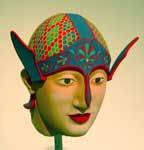
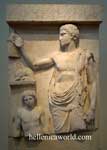
715 : Grave stele. Pentelic marble. Found on Aegina
Byzantine period
Aegina belonged of the East Roman (Byzantine) Empire after the division of the Roman Empire in 395. It remained in Byzantine hands during the period of crisis in the 7th–8th centuries, when most of the Balkans and the Greek mainland were overrun by Slavic invasions. Indeed, according to the Chronicle of Monemvasia, the island served as a refuge for the Corinthians fleeing these incursions.[9] The island flourished in the early 9th century, as evidenced by church construction activity, but suffered greatly from Arab raids originating from Crete. During that time, the population sought refuge in the island's interior, establishing the settlement of Palaia Chora.[9]
According to the 12th-century bishop of Athens, Michael Choniates, the island had become a base for pirates.[9] This is corroborated by Benedict of Peterborough's graphic account of Greece, as it was in 1191, where he states that many of the islands were uninhabited from fear of pirates and that Aegina, along with Salamis and Makronesos were their strongholds.
Frankish rule after 1204
Further information: Frangokratia
After the dissolution and partition of the Byzantine Empire by the Fourth Crusade in 1204, Aegina was accorded to the Republic of Venice. In the event, it came under the control of the Duchy of Athens. The Catalan Company seized control of Athens, and with it Aegina, in 1317, and in 1425 the island came under Venetian control,[10] when Alioto Caopena, at that time ruler of Aegina, placed himself with treaty under the Republic's protection in order to escape the danger of a Turkish raid. The island must then have been fruitful, for one of the conditions under which Venice accorded him her protection, was that he should supply grain to her colonies. He agreed to surrender the island to Venice if his family became extinct. Antonio II Acciaioli was against the treaty for one of his adopted daughters had married the future lord of Aegina, Antonello Caopena.
Venetians in Aegina (1451–1537)
In 1451, Aegina became Venetian. The islanders welcomed the Venetian rule; the claims of Antonello’ s uncle Arnà, who had lands in Argolis, were satisfied by a pension. A Venetian governor (rettore) was appointed, who was dependent on the authorities of Nauplia. After Arnà's death, his son Alioto renewed his claim to the island but was told that the republic was firmly resolved to keep it. He and his family were pensioned and one of them aided in the defence of Aegina against the Turks, in 1537, was captured with his family and died in a Turkish dungeon.
Ιn 1463 came the Turco-Venetian war, which was destined to cost the Venetians Negroponte, most of the Cyclades and their colonies in the Morea. Peace was concluded in 1479. Venice still retained Aegina, Lepanto, Nauplia, Monemvasia, Coron, Modon, Navarino, Crete, Mykonos and Tinos. Aegina remained subject of Nauplia.
Administration
Aegina obtained money for her defences by the unwilling sacrifice of her cherished relic, the head of St. George, which had been carried there from Livadia by the Catalans. In 1462, the Venetian Senate ordered the relic to be removed to St. Giorgio Maggiore in Venice. On 12 November, it was transported from Aegina, by Vettore Cappello, the famous Venetian commander. The Senate gave the Aeginetans 100 ducats apiece towards fortifying the island.
In 1519, the government was reformed. The system of having two rectors was found to lead in frequent quarrels and the republic thenceforth sent out a single official styled Bailie and Captain, assisted by two councilors, who performed the duties of camerlengo by turns. The Bailie’ s authority extended over the rector of Aegina, whereas Kastri (opposite Hydra) had been granted to two families, the Palaiologoi and the Alberti.
A democratic wave passed over the colony. Society at Nauplia was divided into 3 classes: nobles, citizens and plebeians; and it had been the ancient usage that the nobles alone should hold the much-coveted local offices, such as the judge of the inferior court ad inspector of weights and measures. The populace now demanded its share and the Home Government ordered that at least one of the 3 inspectors should be a man of the people.
Aegina had always been exposed to the raids of the corsairs and was cursed with oppressive governors during these last 30 years of Venetian rule. Venetian nobles weren't willing to go to this island. In 1533, three rectors of Aegina were punished for their acts of injustice and we have a graphic account of the reception given by the Aeginetans to the captain of Nauplia, who came to hold and enquiry into the administration of these delinquents. [Vid. Inscription over the entrance of St. George the Catholic in Paliachora.] The rectors had spurned their ancient right to elect islander to keep one key of the money-chest. They had also threatened to leave the island in a body with the commissioner, unless the captain avenged their wrongs. In order to spare the pockets of the community, it was ordered that appeals from the governor’ s decision should lie to Crete, instead of Venice. The republic should pay a bakshish to the Turkish governor of the Morea and to the Voevode who was stationed at the frontier of Thermisi (opposite Hydra). The fortifications too, were allowed to fall into despair and were inadequately guarded.
16th century
After the fall of the Duchy of Athens and the principality of Achaia, the only Latin possessions left on the mainland of Greece were the papal city of Monemvasia, the fortress of Vonitsa, the Messenian stations Coron and Modon, Navarino, the castles of Argos and Nauplia, to which the island of Aegina was subordinate, Lepanto and Pteleon.
In 1502/03, the new peace left Venice with nothing but Cephalonia, Monemvasia and Nauplia, with their appurtenances in the Morea. And against the sack of Megara, she had to set the temporary capture of the castle of Aegina by Kemal Reis and the carrying off of 2000 Aeginetans. This treaty was renewed in 1513 and 1521. All the supplies of grain of Nauplia and Monemvasia had now to be imported from the Turkish possessions, while corsairs rendered dangerous all traffic by sea.
In 1537, Suleyman the Magnificent declared war upon Venice and his admiral Hayreddin Barbarossa spread fire and sword upon the Ionian Islands and in October fell upon the island of Aegina. On the 4th day Palaiochora fell, but the church of St George (Latin church) was spared. He massacred all the adult male population and took away 6000 women and children as slaves. Thence Barbarossa sailed to Naxos, whence he carried off an immense booty, compelling the Duke of Naxos to purchase his further independence by a tribute of 5000 ducats.
With the peace of 1540, Venice ceded Nauplia and Monemvasia. For nearly 150 years after, Venice did not own an inch of soil on the mainland of Greece, except the Ionian dependencies of Parga and Butrinto, but of her insular dominions Cyprus, Crete, Tenos and 6 Ionian islands still remained.
First Ottoman period (1540–1687)
Attack and desolation of the island by Francesco Morosini during the Cretan War (1654).
Second Venetian period (1687–1715)
In 1684, the outbreak of the Morean War between Venice and the Ottoman Empire led to the temporary re-conquest of a large part of the country by the Republic. In 1687 the Venetian army arrived in Piraeus and took command of Attica. The number of the Athenians at that time exceeded 6000, the Albanians from the villages of Attica excluded, and whilst in 1674 the population of Aegina did not seem to exceed 3000 inhabitants, 2/3 of which were women. The Aeginetans had been led to seediness to pay their taxes. The most significant plague epidemic though began in Attica in 1688, an occasion that caused the massive migration of all the Athenians toward south; most of them settled in Aegina. In 1693 Morosini resumed the command, but his only acts were to refortify the castle of Aegina, which he had demolished during the Cretan war in 1655, the cost of upkeep being paid, as long as the war lasted, by the Athenian, and to place it and Salamis under Malipiero as Governor. This led the Athenians to send him a request for the renewal of Venetian protection and an offer of an annual tribute. He died in 1694 and Zeno was appointed at his place.
In 1699, thanks to English mediation, the war ended with the peace of Karlowitz by which Venice retained possession of the 7 Ionian islands, Butrinto and Parga, the Morea, Spinalonga and Suda, Tenos, Santa Maura and Aegina and ceased to pay a tribute for Zante, but restored Lepanto to the Ottoman sultan. The burden of having to contribute to the maintenance of Cerigo and Aegina, both united administratively with the Morea since the peace, the peninsula not only paid all the expenses of administration, but furnished a substantial balance to the naval defence of Venice, in which it was directly interested.
Second Ottoman period (1715–1821)
The Ottomans regained Aegina along with the Morea in 1715, and remained in control of the island with the exception of a short-lived Russian occupation, until the outbreak of the Greek War of Independence in 1821. .
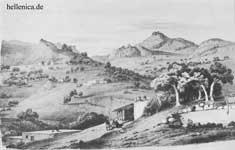
Aigina, 1834
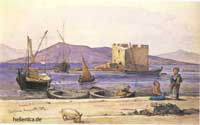

Aegina Port, 30 October 2005 (Source)
Landmarks
Temple of Aphaea, dedicated to its namesake, a goddess which was later associated with Athena; the temple was part of a pre-Christian, equilateral holy triangle of temples including the Athenian Parthenon and the temple of Poseidon at Sounion.
Monastery of Agios Nectarios, dedicated to Saint Nectarios, a recent saint of the Greek Orthodox Church.
Ioannis Kapodistrias, the first leader of free modern Greece (1776–1831) had a large building erected intended for a barracks, which was subsequently used as a museum, a library and a school. The museum was the first institution of its kind in Greece, but the collection was transferred to Athens in 1834. A statue in the principal square commemorates him.
Culture
Mythology
In Greek mythology, Aegina was a daughter of the river god Asopus and the nymph Metope. She bore at least two children: Menoetius by Actor, and Aeacus by Zeus. When Zeus abducted Aegina, he took her to Oenone, an island close to Attica. This island would later be called Aegina. Here, Aegina gave birth to Aeacus, who would later become king of Oenone; henceforth, the island's name Aegina.
Aegina is the gathering place of Myrmidons, in Aegina they gathered and they trained. Zeus needed an elite army and at first thought that Aegina who at the time did not have any villagers was the perfect place. So he turned the ants (Greek: Μυρμύγκια, Myrmigia) into warriors who had 6 hands and wore black armor. Later on Myrmidons were known as the most fearsome fighting unit in Greece led by Achilles.
Famous Aeginetans
Aeacus, the first king of Aegina according to mythology
Smilis (6th century BC), sculptor
Onatas (5th century BC), sculptor
Ptolichus (5th century BC), sculptor
Cosmas II Atticus (2nd century), Patriarch of Constantinople
Paul of Aegina (7th century), medical scholar and physician
Saint Athanasia of Aegina (9th century), abbess and saint
The influential Leoussi family has originated from the isle of Aigina and their roots go as far as the 15th century.
Historical population
Year Town population Municipal/Island population
1981 6,730 11,127
1991 6,373 11,639
2001 7,410 13,552
References
^ Kallikratis law Greece Ministry of Interior (Greek)
^ Herodotus v. 83, viii.46; Pausanias 2.29.9
^ Richard Stillwell, ed. Princeton Encyclopedia of Classical Sites, 1976
^ A. J. Evans, in Journal of Hellenic Studies, vol. xiii. p. 195[when?]
^ C. Michael Hogan, Cydonia, Modern Antiquarian, January 23, 2008
^ Herodotus ii. 178
^ Herodotus vii. 147
^ Mosaic floor of a Jewish synagogue (Sign). Aegina, Greece: Archaeological Museum of Aegina.
^ a b c Kazhdan (1991), p. 40
^ Kazhdan (1991), pp. 40–41
Sources
This article incorporates text from a publication now in the public domain: Chisholm, Hugh, ed (1911). Encyclopædia Britannica (11th ed.). Cambridge University Press.
Welter Gabriel, Aigina, Archäol. Inst. d. Deutschen Reiches, Berlin 1938.
Kazhdan, Alexander, ed. (1991), Oxford Dictionary of Byzantium, Oxford University Press, ISBN 978-0-19-504652-6
Miller William, Essays on the Latin orient, Rome 1921 (reprint: Amsterdam 1964).
Miller William, «Η Παληαχώρα της Αιγίνης. Ηρημωμένη ελληνική πόλις», Νέος Ελληνομνήμων Κ΄ (1926), p. 363-365.
Rubio y Lluch A., «Συμβολαί εις την ιστορίαν των Καταλωνίων εν Ελλάδι», Δελτίον της Ιστορικής και Εθνολογικής Εταιρείας της Ελλάδος Β΄(1885), p. 458-466.
Lambros Spyridon ed., Έγγραφα αναφερόμενα εις την μεσαιωνικήν ιστορίαν των Αθηνών, Athens 1906.
D’ Olwer Nic., Les seigneurs Catalans d’ Egine, τόμος εις μνήμην του Σπυρίδωνος Λάμπρου, Athens 1935.
Koulikourdi Georgia, Αίγινα, 2 vols., Athens 1990.
Moutsopoulos Nikolaos, Η Παλιαχώρα της Αιγίνης. Ιστορική και μορφολογική εξέτασις των μνημείων, Athens 1962.
Nikoloudis Nikolaos, "Η Αίγινα κατά τον Μεσαίωνα και την Τουρκοκρατία", Βυζαντινός Δόμος 7(1993-4), p. 13-21.
Pennas Charalambos, The Byzantine Aegina, Athens 2004.
Greece :
A - B - C - D - E - F - G - H - I - J - K - L - M -
N - O - P - Q - R - S - T - U - V - W - X - Y - Z
| Ancient Greece
Science, Technology , Medicine , Warfare, , Biographies , Life , Cities/Places/Maps , Arts , Literature , Philosophy ,Olympics, Mythology , History , Images Medieval Greece / Byzantine Empire Science, Technology, Arts, , Warfare , Literature, Biographies, Icons, History Modern Greece Cities, Islands, Regions, Fauna/Flora ,Biographies , History , Warfare, Science/Technology, Literature, Music , Arts , Film/Actors , Sport , Fashion --- |
Retrieved from "http://en.wikipedia.org/"
All text is available under the terms of the GNU Free Documentation License




